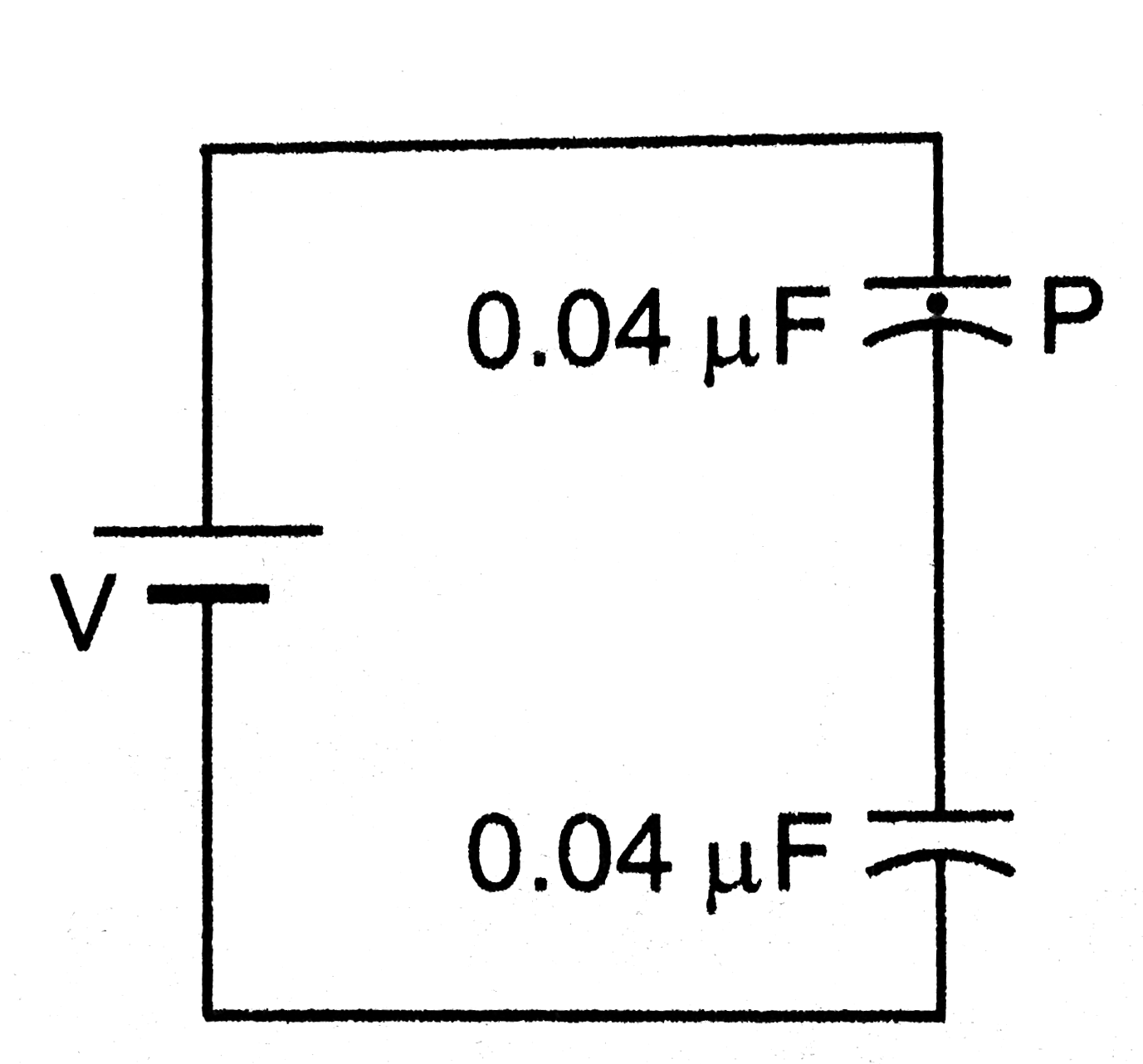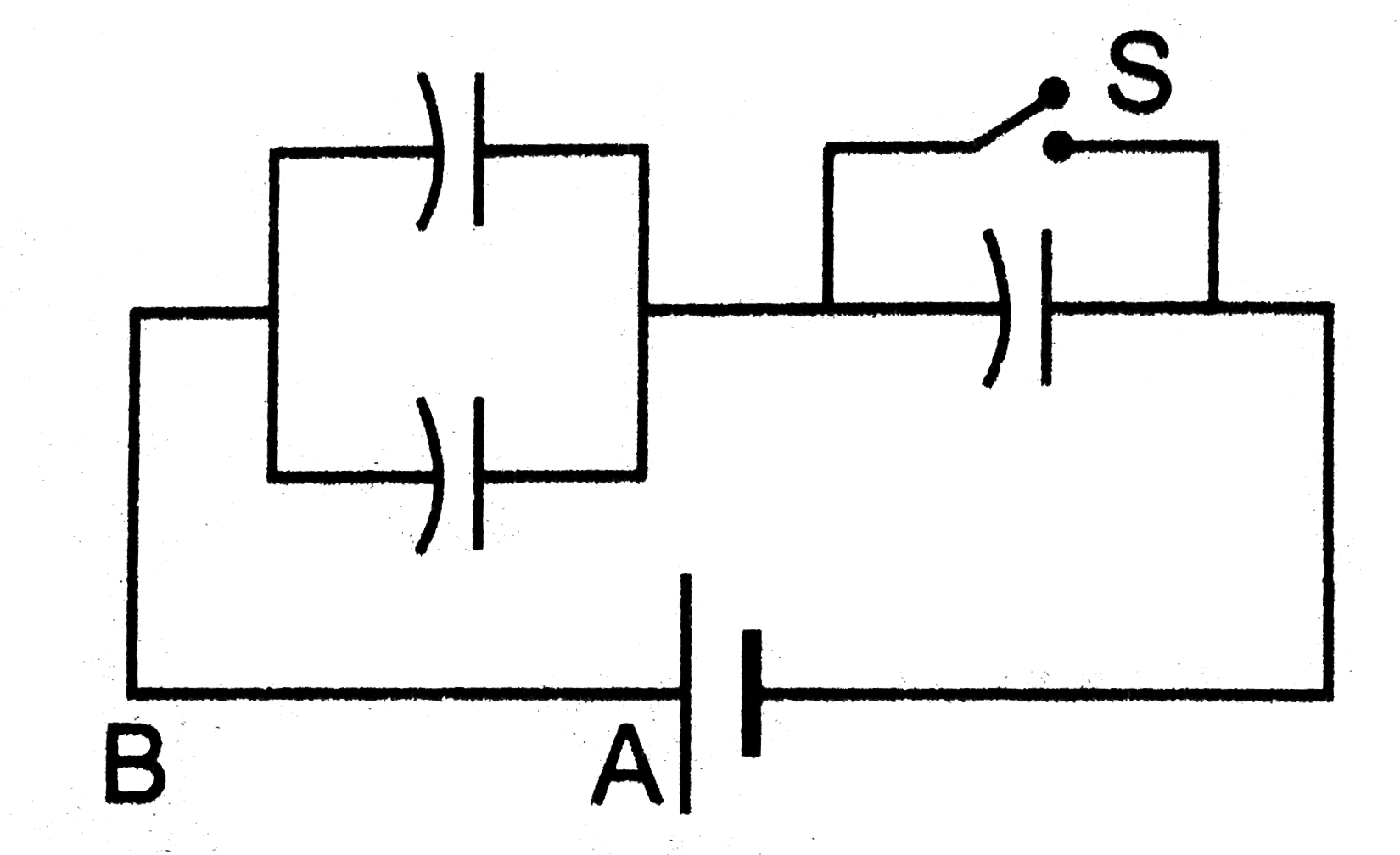The particle P shown in figure has a mass of 10mg and a charge of - 0.01μC. Each plate has a surface area 100cm2 on one side. What potential difference V should be applied to the combination to hold the particle P in equilibrium?
 Solution in Gujrati
Solution in Gujrati
Let the velocity of elctron = V ,
mass of electron = m
Equivalent capacitance = C<br>((eplison_0a^(2)/(d_1)xx(epsilon_0 a^2))/(d_2)/((eplison_0a^(2)/d_1)+(epsilon_0 a^2))
=eplision0a2d1+d2
(because capacitors are in series)
Horizontal distance = V xx t<br>Vertic≤distance,y = 1 / 2 at^(2)<br>Ae≤rtionofe≤ctrona = qE / m<br>y = d_1<br>So,d_1 = 1 /2 qE / m t^(2) <br>or d_1 = 1 / 2 qE / m (x /v ) ^(2) <br>or,q = CV<br>Putthevalueoftheequation(i),q,E,we≥t,<br>miniμmvelocityate≤ctron<br>= ( V qa^(2) / md_1 (d_1 - d_2) ^(1/2)
Topper's Solved these Questions
- CAPACITORSBOOK - HC VERMACHAPTER - CAPACITORSEXERCISE - Exercise
2 Videos
- CAPACITORSBOOK - HC VERMACHAPTER - CAPACITORSEXERCISE - Objective 2
7 Videos
- BOHR'S MODEL AND PHYSICS OF THE ATOMBOOK - HC VERMACHAPTER - BOHR'S MODEL AND PHYSICS OF THE ATOMEXERCISE - Exercises
46 Videos
- DISPERSION AND SPECTRABOOK - HC VERMACHAPTER - DISPERSION AND SPECTRAEXERCISE - Exercises
11 Videos
Similar Questions
The plates of a paraller-plate capacitor are made of circular discs of radii5.0cm each .If the separation between the plates is 1.0mm,What is the capacitance?
View SolutionThe capacitance of a capacitor does not depend on
View SolutionThe bohrradius is given by a0=ε0h2πme2 verify that the RHS has dimesions of length
View SolutionA flint glass prism and a crown glass prism are to be combined in such a way that the deviation of the mean ray is zero. The refractive index of flint and crown glasses for the mean ray are 1.620 and 1.518 respectively. If the refracting angle of the flint prism is 6.0∘, what would be the refracting angle of the crown prism ?
View SolutionThe particle P shown has amass of 10mg and a charge of−0.01μC.Each plate has a surface area

View SolutionThe particle P shown in the figure has a mass of 10 mg and a charge of -0.01 muC . Each plate has a surface area 10^(-2) m^2 on one side. What potential difference V should be applied to the combination to hold the particle P in equilibrium?
View SolutionIn a parallel capacitor the potential difference between the plates is V ,A particle of mass m and charge −Q leaves the negative plate and reaches the positive plate at distance d in time t with a momentum p .Then
View SolutionIn figure-6.105, particle A has a mass of 1.4 and particle B has a mass of 3.1 kg . What is the gravitational field at point P ?
View SolutionA capacitance balance is shown in figure. The balance has a weight attached on one side and capacitor that has a variable gap width on other side. Assume the upper plate of the capacitor has negligibles mass. When the potential difference between the plates is V_(0) , the attractive force between the plates balance the weight of the hanging mass, Then:
View SolutionA particle of mass 1.96×10−15 kg is kept in equilibrium between two horizontal metal plates having potential difference of 400 V separated apart by 0.02 m. then the charge on the particle is (e= electronic charge)
View SolutionThe particle P shown in the figure has a mass m and a charge -q. Each horizontal plate has a surface area A potential difference V=n((mg epsilon_(0)A)/(2qc)) should be applied to the combination to hold the particle p in equilibrium then find the value of n.
View SolutionTwo metal plates having a potential difference of 800 V are 0.02 m apart horizontally. A particle of mass 1.96×10−15 kg is suspended in equilibrium between the plates. If e is the elementary charge, the charge on the particle is
View SolutionA capacitance balance is shown in figure. The balance has a weight attached on one side and capacitor that has a variable gap width on other side. Assume the upper plate of the capacitor has negligibles mass. When the potential difference between the plates is V_(0) , the attractive force between the plates balance the weight of the hanging mass, Then:
View SolutionA particle of mass 1.96×10−15 kg is kept in equilibrium between two horizontal metal plates having potential difference of 400 V separated apart by 0.02 m. then the charge on the particle is (e= electronic charge)
View SolutionThe particle P shown in the figure has a mass of 10 mg and a charge of -0.01 muC . Each plate has a surface area 10^(-2) m^2 on one side. What potential difference V should be applied to the combination to hold the particle P in equilibrium?
View SolutionThe particle ‘P’ shown in figure has a mass of 10 mg and a charge of -0.01muc . Each plate has a surface area 100 cm^2 on one side. Potential difference V applied to the combination to hold the particle P in equilibrium should be
View Solution
